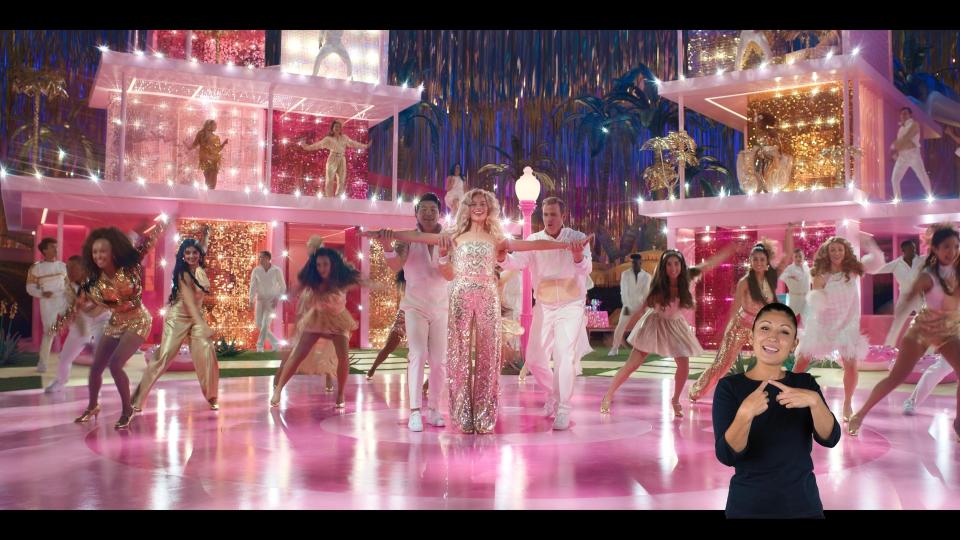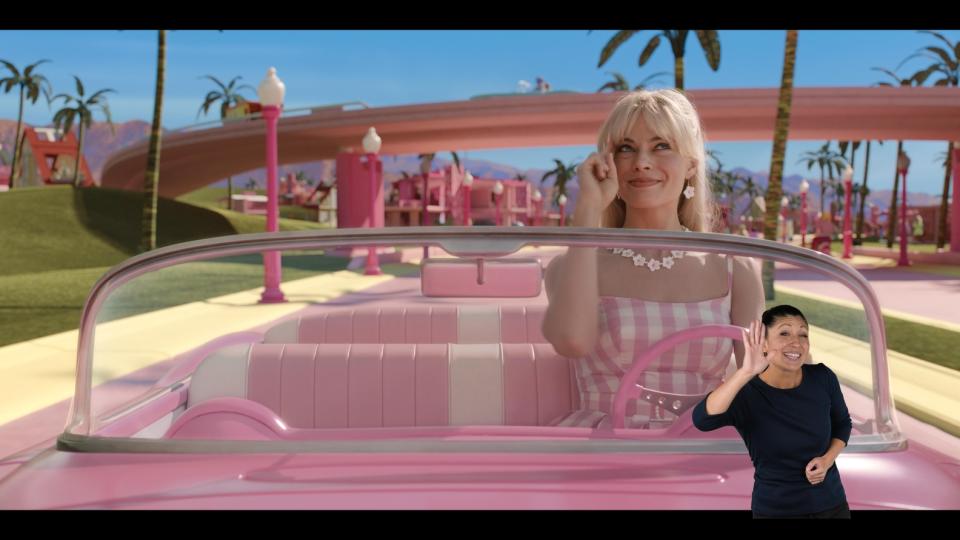‘Barbie’ Has a New Star in Max’s ASL Interpreter, Who Even Has a Sign for ‘Kenough’

At the end of a Los Angeles screening of “Barbie” December 14, many in the buzzing crowd didn’t applaud. Instead, they twisted their hands in the air, the American Sign Language gesture for Applause, in praising Deaf ASL performer Leila Hanaumi.
The audience watched Hanaumi perform “Barbie” dialogue in ASL for the entirety of its near two-hour runtime, but even better was they saw the actress larger than life, overlaid on the movie screen.
More from IndieWire
Hanaumi’s performance was part of an ASL version of “Barbie” that debuts today on Max, alongside the English language original. Hanaumi, a Deaf actress and ASL interpreter, can be seen in the corner of the screen, signing and translating into ASL throughout the movie and interpreting every role in an effort to make the year’s biggest blockbuster accessible for the widest possible audience.
“It’s more than just a movie. It is a cultural phenomenon,” Hanaumi told IndieWire through an interpreter. “The fact that this movie is being made accessible in ASL shows the deaf community, we’re part of this conversation. We are not left out of the conversation like we usually have been in history before. We are part of this process, not as an afterthought.”
ASL performance is still rare in Hollywood, but it’s not new. Disney released ASL videos of performers signing along to songs from “Encanto.” Hanaumi interpreted music videos for the singer Tove Lo. And various animated titles incorporated sign language into the project itself. But for Max, it’s a first.
The Max product team believes this is the first time that a movie’s ASL version has been available on a streamer on the same day as the original. Most of all, this isn’t a temporary release or something only available on YouTube. It’s a streaming title on Max, treated as any other and easy to find.
Hanaumi recalls watching “Sesame Street” as a kid and seeing an ASL performer on screen. But as captions became more prevalent, real-life examples of people hired to interpret a movie or show became harder to find.
“I remember being in awe when I saw somebody like me signing in my language on screen. And I realized what full accessibility felt like at that moment,” she said. “I just got used to the idea of understanding movies with captions only. I forgot what true accessibility felt like until now.”
Younger kids who watch “Barbie” will appreciate Hanaumi since they can’t process captions as quickly, but she says it’s important because captions alone don’t fully capture nuances and context.
“As a deaf person, it still isn’t as natural. It still isn’t a natural language,” Hanaumi said. “Ninety percent of deaf kids are born to hearing parents and many of them never have access to sign language at all. That is language deprivation, and it’s a serious issue in our community. Being able to provide ASL access is a way to just level the playing field and allow a Deaf viewer to access the movie with cultural conceptions that we are able to understand in a more natural way.”
Max approached the ASL “Barbie” simply as a way of offering another language to its users. The product team had long wanted to create an ASL version for a Warner Bros. title, but the message of inclusivity made “Barbie” feel like the right one. It doesn’t hurt that the Mattel lineup includes an ASL Barbie doll, even if Barbie’s hand is permanently stuck in the “I Love You” sign.
“What was great is that every conversation that we had from there on, every room that we walked into with that pitch deck, it was really kind of a snowball of positivity, which really confirmed our belief that this was something that we absolutely had to do,” said Naomi Waibel, senior VP of global product management for Warner Bros. Discovery.

Waibel and her team including WBD’s Arturo Garcia and Delaney Cunningham researched what a Deaf audience specifically wanted: Where should the interpreter be placed on screen? How big should they be? What should they be wearing?
In the film, Hanaumi is placed in the right corner and takes up about a lower third. The team settled on a black long-sleeve shirt so to not distract from the film. Hanaumi is also overlaid on the screen rather than to the side in a separate window.
Thursday’s screening displayed Hanaumi along with open captions, but the Max version has the option to disable captions and just view Hanaumi’s interpretation. Waibel said some users requested the ability to flick the interpreter to different corners of the screen should they choose, but that wasn’t possible this time around.
The biggest question was whether the film should have multiple interpreters on screen or just one. Deciding that Hanaumi should be the film’s sole interpreter, rather than an ensemble, presented an enormous performance challenge. She had to alternate between multiple speaking roles and overlapping dialogue, capturing everything from Helen Mirren’s narration to Lizzo’s background song.
At one point she signs the gesture of a jackhammer when one can be heard in the background. And though it’s not actually spoken in the movie, Hanaumi does know a sign in ASL for “Kenough.” (It’s only seen on a sweater Gosling’s Ken is wearing.) She makes the traditional ASL sign for “enough,” making a fist with one hand and brushing the palm of her other hand on top of it. But instead of using a flat palm, she now makes her hand into a “K.”

Hanaumi spent years interpreting movies for her two young deaf children, but she didn’t initially recognize the complexity of interpreting an entire movie. “I thought, I’ve been doing this my whole life. But when I actually started doing the work, I realized, oh no, I don’t actually interpret every word,” she said. “I don’t realize how much I skip certain things. I’m sorry to my kids. You know what? We all do it.”
Hanaumi got the role in September and spent about three weeks studying the script, watching the film multiple times, and working with ASL coach Jac Cook. During filming, she watched the movie and signed along in real time. The project’s director then broke the whole film down into 32 chunks in which she’d have to perform an un-interrupted take for each, the longest being about five minutes.
“You had parallel narratives going on,” she said. “I had to make sure that my signing speed and my demeanor matched the fun, cheerful vibe while making sure that my signing choices conveyed the depth.” The performance demanded she talk for Barbie one moment and Ken the next. She might adjust her posture or facial expressions slightly to account for who’s speaking — broadening her shoulders to capture Will Ferrell as Mattel’s CEO, or putting on a slight smirk for Ken.
Often someone would begin speaking before they’re seen on screen, so she had to begin signing in anticipation. Hanaumi adjusts her body and leans to the left and right to account for the different speakers in conversation. And when Barbie (Margot Robbie) talks with the doll’s petite creator Ruth (Rhea Perlman), Hanaumi adjusts her eye level slightly to demonstrate the speaker looking up or down. While filming, she watched the film in mirror mode to move in the correct direction while facing an audience.

“My job with ‘Barbie’ was to become part of the movie and to stay as authentic to the character and their lines as much as I could as possible,” she said. “It wasn’t about what or how I would like to express myself as an artist. It’s about how do I make sure that the Deaf viewer related to the movie? I’m becoming like a vehicle or medium for the Deaf people to be able to fully access the movie that’s already been made.”
In a panel discussion with Hanaumi after the screening, Robbie said she was in awe of the interpreter’s commitment and suggested it was something that every actor should watch.
“You were replicating the performances but making it your own,” Robbie said. “It’s stunning work. I want actors everywhere to see you do that because you shape shifted every couple of seconds. It was simply incredible. Well done.”
Hanaumi had as many kind words for Robbie’s performance and getting the chance to embody her. “I have no doubt that this will be a cult classic hit forever,” Hanaumi said. “It’s really touching to me to know that the Deaf community has full access to a movie like this.”
Best of IndieWire
The Best LGBTQ Movies and TV Shows Streaming on Netflix Right Now
Guillermo del Toro's Favorite Movies: 54 Films the Director Wants You to See
Nicolas Winding Refn's Favorite Films: 37 Movies the Director Wants You to See
Sign up for Indiewire's Newsletter. For the latest news, follow us on Facebook, Twitter, and Instagram.

